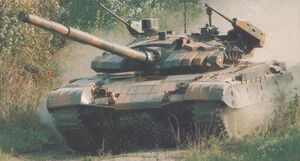KH 102M Hunyadi
This article is incomplete because it is pending further input from participants, or it is a work-in-progress by one author. Please comment on this article's talk page to share your input, comments and questions. Note: To contribute to this article, you may need to seek help from the author(s) of this page. |
| KH 102M Hunyadi | |
|---|---|
 The Hunyadi-II introduced in 2002. | |
| Type | Main battle tank |
| Place of origin | |
| Service history | |
| Used by | see users |
| Production history | |
| Designer | Győrharckocsigyár |
| Produced | 1995-present |
| No. built | 283 |
| Specifications | |
| Weight | 43.5 tonnes |
| Length | 9.8 metres (gun forward) |
| Width | 3.8 meters |
| Height | 2.3 meters |
| Crew | 3 |
| Armor | Steel and composite Armor |
Main armament | PL 100M 125 mm smoothbore gun |
Secondary armament | 12.7 mm HMG 2x20mm autocannon (Hunyadi-I) 30mm autocannon (Hunyadi-II) |
| Engine | Diesel Engine 850 hp |
| Suspension | Torsion-bars |
Operational range | 480 km |
| Speed | 60 km/h |
The KH 102M Hunyadi or Közepes Harckocsi 102 Minta Hunyadi is a main battle tank developed by Granzery to replace its aged fleet of Panzer 60 and Panzer 30 main battle tanks. It is the most common tank in service with the Granzerian Royal Defence Force, and all models in current service are of Hunyadi-II type.
Development
After the Unification of Granzery in 1983, the Granzerian Royal Defence Forces were left with a sizeable stock of Panzer 60 and Panzer 30 tanks, most of which were upgraded to modern standards as of 1983. By the early 1990s these tanks were becoming increasingly obsolete with the widespread introduction of 3rd generation main battle tanks such as the Vonzumieran Panzer 56 and Vierz Panzer 80. This led to a desire within the RDF to replace their tank fleet with an inexpensive modern main battle tank that would be sufficient to serve into the 2020s. Entered into this competition were the Vonzumieran Panzer 56, as well as the Tieradan TBA, Apelian TBA and Aitic Psrvn 73 and Psrvn 76 tanks. Three Granzerian prototypes were also entered into this competition, the first was an offered upgrade package of the Panzer 60 by Granzerian firm FÉMC, which included composite armour, a new 120mm gun and comprehensively upgraded internals, the second prototype was known as the P94Z and was a joint project by Granzerian Firms Csepel and Malév.
The final tank prototype offered for the competition was produced by Granzerian company Győrharckocsigyár and became the KH 102M Hunyadi, originally a modification of three Psrvn 73 tanks which had been provided in the mid 1980s for evaluation by the Granzerian military, the internals had been completely overhauled and the tank rebuilt from the ground up with all-Granzerian parts, with heavily upgraded FCS, optics, as well as Granzerian-produced cage armour and ERA armour. The Hunyadi proved during the trials to match or exceed the capabilities of contemporary foreign main battle tanks while operating at a much lower price point.
Production history
Service History
Combat history
Design
Armament
Mobility
Protection
Variants
Domestic Variants
- 95M Hunyadi I: The 95M Hunyadi was the first production variant of the Hunyadi introduced in 1995, this model has 2 20mm autocannons on either side of the turret, as well as drastically upgraded FCS and Optics based on the FCS of contemporary western MBTs suck as the Panzer 56 Lowe. In addition to these upgrades, the internals of the baseline Psrvn-73 have been completely replaced with similar parts manufactured in Granzery, including the addition of Granzerian-manufactured Kazamata-1 ERA.
- 102M Hunyadi II: Introduced in 2002, the Granzerian Hunyadi II was developed as an upgrade to the 95M Hunyadi I. Most noticeably, the tank is fitted with Granzerian-made Kazamata-2 explosive reactive armor and improved cage armor that provides further protection against RPG rounds. The twin 20mm cannons have also been replaced by a single top-mounted 30-mm autocannon.
- PclGépj 102M: Engineering vehicle derived from the 102M Hunyadi II.
- PcHszJ 102M: Armoured Recovery vehicle derived from the 102M Hunyadi II.
